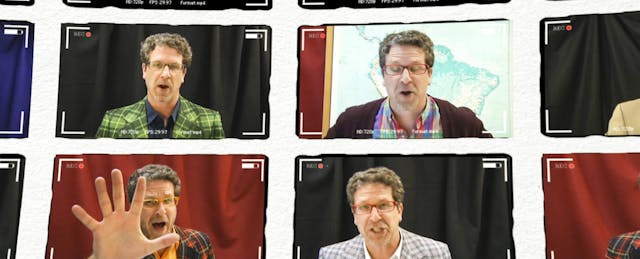A few years after John Boyer began teaching world geography at Virginia Tech, a survey revealed that 58 percent of college-aged Americans could not locate Japan on a map. Sixty-nine percent could not find the United Kingdom.
Boyer raced ahead undaunted. He loved the scope and implications of his subject. “The great thing about geography is . . . everything happens somewhere,” he explains. “Geography is the somewhere.”
Boyer is now a senior instructor and researcher at Virginia Tech. He took over World Regions, an entry-level geography class, while he was working on a master’s degree nearly 20 years ago. The class then had 50 students. Now the course is offered each semester and a whopping 3,000 students take it in any given school year.
What has made it so popular? Innovative pedagogy, for starters. Boyer uses a “flipped syllabus” in which students' final grades are based on the points they've earned—not lost—throughout the semester. His legendary assignments range from reviewing films to tweeting on behalf of world leaders (more on that below). Mostly, Boyer himself has made the class a rite of passage for undergraduates, who typically find him funny, passionate, and consummately engaging. Boyer even created a comic alter ego called the Plaid Avenger, who has narrated textbooks and podcasts but is now largely retired—though Boyer still sports his famous plaid jackets and drives a plaid Scion.
Beloved? Boyer has received the Students’ Choice Award as a Faculty Member of the Year for 13 straight years. He has also been named a Master Educator by Course Hero, an education technology company that produced a short film on Boyer.
Professor John Boyer teaches World Regions through his comic book alter ego. You can also watch this Course Hero video on Vimeo.
We sat down with Boyer to learn more about his flipped syllabus, unique assessments, and the hard work that goes into an easy A.
EdSurge: How did your course become an online class?
John Boyer: About seven years ago we started live-streaming World Regions. I would still teach the course in person but we would also live-stream it, and increasingly people were just watching it online. By the last class each semester no one was showing up. So I said let’s just go ahead and move it online and experiment with that.
Five or six years ago we started recording all my lectures—not live lectures, but actually in a studio. We converted my office into a studio. We recorded them all and tried to make them into more bite-size pieces. If normally I’d do a lecture on China that would span three hours, I would try to break that up into consumable bites, anywhere from 15 to 20 minutes, broken down by particular topics. I was still telling a linear story about China, from physical geography to history to current events.
What would you tell other educators who want to move some or all of a course online?
I’m a big fan of human interaction, and if a class is not going to be live, then you have to get it as close to live as possible. You have to use video.
When you see a video of somebody versus just hearing their voice, you pick up facial cues. There’s a myriad of information I’m portraying through my face and my hand gestures that even I don’t realize.
I’ve also done online office hours in a live format, where students, alumni, or random visitors basically used AOL Instant Messenger or Google Talk to ask questions. We use a free online service called Ustream to make it possible for students everywhere to watch. It’s another way to keep people engaged.
What does your video operation look like?
At this point we have a camera on a tripod set up in my office with a curtain backdrop. We actually have five or six different colors of curtains that I can change for my mood or the mood of the lecture.
My technical assistant Katie Pritchard is the editor who takes the raw file and uses Final Cut to do her editing. She puts in notes that reinforce the main themes and adds photos of geographical features and heads of state. We also use a lot of maps from the Perry-Castañeda Library Map Collection. And then she puts the finished videos up on YouTube and Vimeo.
You’ve created what you call a “flipped syllabus,” where students start at zero and accumulate points toward their grade rather than start with a perfect score and lose points on tests and papers. How did that come about?
If you try to have regimented exercises, every single person has to do the exact same thing. With nearly 3,000 students, it’s a logistical nightmare. There are people who have health issues and family issues and attention deficit disorder and they’re on sports teams. We learned you can’t do the same thing for everybody.
The second reason I developed the flipped syllabus is that when you’re teaching an introductory-level course like this, you have some people who are just clueless about the content. Most of my content is about international stuff and most Americans are woefully inept at what’s going on in the world. At the same time I have a contingent of students coming in who are ready for their PhDs, who are smarter than me and they already know all this stuff.
Given the disparity in knowledge levels as well as the disparity in what they like to do in terms of work, whether that be watching international film or writing papers, I wanted to increase the flexibility of what the students could do to achieve a grade in this class.
What are some of the ways students in World Regions can earn points?
It takes 1,130 points to get a C, and 1,350 points to get an A. Every week there is a book reading quiz. You can read a chapter or two of the book and take quizzes, each worth a maximum of 30 points. There’ll be a recorded lecture series, and you can go watch that and take quizzes. There’ll be an international film for the week. You can watch that and write a short review worth up to 40 points.
And there are a variety of alternative assignments, like the Twitter World Leader assignment. (See below for details on Boyer’s assignments.)
Tell us about the Twitter World Leaders.
You can choose to be a true, real world leader. Of course, they’re fake accounts and we make sure everyone knows you’re the fake Donald Trump or the fake Angela Merkel of Germany. Once you take on that role, you will tweet as the world leader for the entire semester, and you have to tweet two to three times a day. And it’s not silly stuff. What is the chancellor of Germany working on right now? What other world leaders is Angela Merkel meeting with? What’s going on in Germany or the EEU?
Over the course of the semester, the student, two or three times a day, writes 140 characters. If you do that for 3 ½ months, it’s pretty much a 20- or 30-page term paper. With this assignment, you have to be fully engaged, following this person every day and learning about what’s motivating them and reporting on it, basically, one sentence at a time.
Most people walk away from this saying, “Wow, I learned way more than I thought I was going to.”
Does a flipped syllabus lead to a lot of A’s?
I give out a whole lot of A’s. I can think of nothing worse than failing people on a topic that you’re so passionate about and you have dedicated your life to. I give people more than enough chances to succeed. Does that make the class an easy A? Hmmm? I guess.
But if you ask students in this course, is it an easy A, people would say, “Oh yeah, it was an easy A. But you had to work your ass off.”
And I’ll take that compliment every day of the week.
Seven Ways to an A
In Boyer’s flipped syllabus, students have a slew of opportunities to earn points toward their final grade. For undergraduates in World Regions, the road to an A is paved with:
1) Weekly book reading quizzes—Each week a quiz is posted on Moodle—a free LMS—with questions arising from the two assigned chapters from The Plaid Avenger’s World.
2) Weekly video lecture quizzes—Each week a number of pre-recorded video lectures are assigned, followed by three or four related quizzes.
3) Current events flash quizzes—Boyer creates a video podcast about a particular current event issue, creates a “flash” quiz on material covered in the podcast, and announces the quiz using social media.
4) International film assignments—Watch the foreign movie of the week and then take a quiz on the film.
5) Non-class events papers—Attend an internationally themed event—lecture, film, art exhibit, live performance, or cultural or religious festival—on campus and write a paper of at least three pages that links the event, as much as possible, back to material covered in the class.
6) International interview project—In a campus sound studio, interview an international student or faculty member about his or her home country for 20 to 30 minutes, then submit the sound file.
7) World Leader Twitter assignment—Choose to portray one of 200 world leaders during the semester and tweet at least twice a day about what that leader is doing, thinking, feeling, where he or she is, and with whom he or she is meeting.

Cinema Paradiso
Boyer has long sponsored a weekly International Film Night as part of his World Regions class. He shares some of his favorite foreign films:
“Aftershock” (2010, Chinese, directed by Xiaogang Feng)—An absolutely awesome teaching tool for many different aspects of Chinese culture. The film depicts the aftermath of the (very real) 1976 Tangshan earthquake. Huge student favorite, though most people are literally crying at the end.
“City of God” (2002, Brazil, directed by Fernando Meirelles and Kátia Lund)—A gritty street portrait of a great world city. Brazilian crime drama spanning two decades.
“Good Bye Lenin!” (2003, Germany, directed by Wolfgang Becker)—Black comedy with a semi-romantic storyline that is easily the best teaching device for explaining the Cold War in Europe and the fall of the Berlin Wall.
“Lumumba” (2000, France/Germany/Belgium/Haiti, directed by Raoul Peck)—Historically accurate and intriguing portrayal of Patrice Lumumba in the months before and after the Democratic Republic of the Congo achieved independence from Belgium in 1960.
“Motorcycle Diaries” (2004, Brazil, directed by Walter Salles)—Buddy road trip film set in South America in 1952 that focuses on the ideological development of a young Ernesto “Che” Guevara. Examines wealth disparity across Latin America, with great historical tidbits along the journey. Fantastic on-location cinematography.
“Paradise Now”(2005, Palestine, directed by Hany Abu-Assad)—Unsettling political thriller about two Palestinian men preparing for a suicide attack in Israel. Realistically portrays the evolving mindset behind such extreme behavior.
“Persepolis” (2007, France, directed by Vincent Paronnaud and Marjane Satrapi)—Spartan black-and-white animation masterfully follows a young girl as she comes of age against the backdrop of the 1979 Iranian Revolution.
“Prisoner of the Mountains” (1996, Russia, directed by Sergei Bodrov)—Based on a Leo Tolstoy story, this war drama illustrates the conflicting views between traditional (Islamic) Chechen culture and the Russian state. Amazing cinematography from the Caucasus Mountains of Dagestan.
“Rabbit-Proof Fence” (2002, Australia, directed by Phillip Noyce)—Australian drama set in 1931 and loosely based on a true story about three mixed-race girls who were forcibly removed from their Aboriginal mothers, put into an orphanage outside of Perth, and then escaped and walked for nine weeks along 1,500 miles of a rabbit-proof fence to return to their community. Great soundtrack by Peter Gabriel, too.
“Sin Nombre” (2009, Mexico, directed by Cary Fukunaga)—Gritty, sporadically ultra-violent, adventure/crime/thriller film about a Honduran girl who is trying to immigrate to the United States and meets up with a boy caught up in the violence of MS-13 gang life who also needs to escape.
“Tae Guk Gi: The Brotherhood of War” (2004, South Korea, directed by Je-kyu Kang)—Two brothers are forcibly drafted into the South Korean army at the outbreak of the Korean War and end up fighting for survival—on different sides of the conflict. More timely than ever.
“Tsotsi” (2005, South Africa, directed by Gavin Hood)—Powerful human drama set in a Johannesburg slum. Tsotsi is a young street thug who steals a car only to discover a baby in the back seat.
“Waltz with Bashir” (2008, Israel, directed by Ari Folman)—My favorite animated film of all time, made all the more haunting when you find out that it is actually a series of documentary interviews carefully crafted into a linear storyline that shows the writer/director suffering traumatic memory loss of his experience as a soldier in the 1982 Lebanon War.



